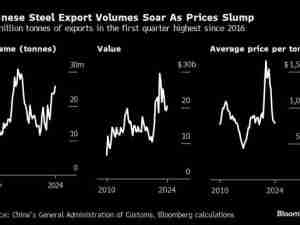The Philippines, the world’s second-biggest nickel supplier, may follow neighboring Indonesia by taxing exports of the metal, adding to supply uncertainties as the market adjusts to a wave of new demand from electric vehicles.
The Southeast Asian nation is considering fees on exports among measures to encourage investment in processing plants, Environment and Natural Resources Secretary Antonia Yulo Loyzaga said in an interview in her office on Monday.
The tentative plan echoes a strategy pursued by Jakarta over the past decade that roiled the global nickel market as it reconfigured trade flows and spurred a wave of new refineries in Indonesia. It also provided a prime example of a resource-rich country pushing for more value from its minerals.
“We want to move out from being just part of the supply chain. We want to be part of the value chain,” Loyzaga said. Without processing of mineral ores, “we will just be a vendor country. And we don’t want to be a vendor country.”
Higher export costs from a key supplier could tighten supply and push up nickel prices, analysts said, but they also cautioned that implementation was uncertain, and that the Philippines will not have as much sway as Indonesia. It accounts for about 11% global mined nickel supply, versus 48% for Indonesia.
Concerns
Export taxes “would create sales barriers for Philippine miners, and nickel prices would surge,” Shao Wanyi, an analyst with Shanghai-based Guotai Junan Futures Co. Still, it is a medium-to-long term plan and the market will monitor the actual development of the policy, Shao said.
Indonesia and the Philippines are the world’s biggest suppliers of nickel — used in making stainless steel and in lithium-ion batteries for electric vehicles — to top market China. Indonesia’s ban on exports of metal ores in 2020 boosted the value of its nickel exports from $3 billion to $30 billion in two years as Chinese companies built refineries and smelters there.
One headwind for Manila in building a downstream industry is that the quality of ore in Philippines is generally lower than in Indonesia. That makes refining more expensive and technologically more difficult.
“This might be a concern or obstacle for investors making a decision to invest in processing plants as they need to see a secured return,” said Gao Yin, an analyst at Horizon Insights. “Any taxes will inflate costs for Chinese stainless-steel mills” that are the main users of Philippines nickel ore.
Nickel closed 1.1% higher on the London Metal Exchange on Monday and will re-open later on Tuesday. Futures in Shanghai rose 1% Tuesday, extending gains since mid-January.
Opening Up
President Ferdinand Marcos Jr.’s government is seeking to boost mining to further grow the economy that posted its strongest expansion in nearly five decades last year. Less than 3% of 9 million hectares identified by the government as having high mineral reserves is actually being mined.
The government was mulling “a range of actions including a progressive look at taxing exports” of raw nickel, Secretary Loyzaga said. Her agency’s Mines and Geosciences Bureau had earlier suggested for the Philippines to “go by way of Indonesia,” she added.
Inspired by Indonesia’s success, the government is weighing whether to impose an export tax on raw nickel exports or ban ore shipments completely, Trade Secretary Alfredo Pascual said, according to a Manila Bulletin report.
While acknowledging concerns about “resource nationalism,” Loyzaga said the Philippines needs “to balance the pace at which we are going to be opening up this sector and make sure that we are not going to be running short.”
The Philippines has 55 metallic mines and seven mineral processing plants, including two for nickel operated by Nickel Asia Corp., which is partly owned by Japan’s Sumitomo Metal Mining Co. Loyzaga said her target is to add three more mineral processing facilities during her term.
The country’s nickel output dropped 17% from a year earlier to 22.5 million dry metric tons in January-September 2022, according to the latest available government data. But Loyzaga says she expects shipments to rise this year amid “great demand” for nickel.
After overseeing a crackdown early in his term that shut most of the Philippines’ mines, Rodrigo Duterte, Marcos’s predecessor, who once said the nation can survive without a mining industry, eventually allowed new mineral deals and lifted a ban on open-pit mining in 2021. “So far we have assessed them and found them to be mining responsibly,” Loyzaga said on how mines are operating currently.
The government is talking with some large-scale miners from Canada and Australia that are keen on doing business in the Philippines, she said, declining to give further details. At home, it is also pushing for mining projects stalled for years by changes in mining policy, including the Tampakan mine in southern Mindanao island.
The mine, one of the largest untapped mineral resource in Southeast Asia and estimated to yield 375,000 tons of copper and 360,000 ounces a year of gold in concentrate over a 17-year period, had been halted by the open-pit mining ban, prompting Glencore Plc to quit the project in 2015.
Loyzaga is scheduled to meet with local Mindanao officials this week and is hopeful any further hurdles for Tampakan will be cleared. “We need to move forward,” she said.





